In an ironic twist, I’d started writing this year in review at beginning of December. It’s been a bit of a wild ride since then with the COVID Omicron variant. But I guess nothing resumes this year better than all the chaos that this variant has wrought and how everyone is dealing with it.
It feels weird to even talk about it sometimes. Everyone has had such a different experience of life with COVID. Obviously, it changes per country, but even within a country or even a city, someone’s experience was quite different.
For some, COVID ended in June 2020. For others like me, it never really stopped. We’re back to being in lockdown with a curfew here. Being mostly confined to my home hasn’t been the best for my mental health.
This is why these year in review posts are so important to me. If you didn’t know, I’ve been doing these year in reviews since 2015. They’re an important journey documentation tool for me.
I feel I need to document how COVID affected me, even if it’s different for everyone. But if you struggled with COVID, know you’re not alone. If you’d rather not read about it, that’s ok! Feel free to just skip further ahead.
Living through the longest lockdown in North America
I believe Montreal (where I live) had the longest near-continuous lockdown in North America. It started on October 1st 2020 and ended on May 28th 2021. During most of that time, we also had a curfew where you weren’t allowed outside between 9:30pm and 5am without getting fined thousands of dollars.
I didn’t celebrate Christmas or New Year. I actually had to isolate because of potential COVID exposure. (I was planning on breaking the rules for Christmas.) At that point, I had seen no one in three months.
As a pretty extroverted person, this lockdown had a significant impact on my mental health. I didn’t leave my apartment for eight months except to do groceries. I only saw friends and family through Zoom calls, with a few outside interactions sprinkled here and there.
And, as I discussed in last year’s review, these didn’t really help me feel better.
US Capitol attack and its effect
When January started, I felt like it’d be an ok month. I’d taken time off everything during the holidays. (Something I’m trying to do again this year.) I’d started to ramp up work again.
But then the US Capitol attack happened. I’m not American. So it might sound weird that an event like that would affect me that much, but it did.
I think that, with the lockdown isolation, something kinda snapped when the attack happened. Afterwards, there was an emptiness in me I couldn’t shake. I was pretty indifferent about everything.
I started playing video games more. Not so much that I didn’t do a bit of work every day.
I lost the drive to work on Ymir for hours a day. If anything, this probably gave me a better work-life balance. (For a while anyhow.) But the reason I stopped working so hard on Ymir was that it felt pointless.
I worked so hard on Ymir because I wanted it to be in a good spot when things were normal again. I’d be travelling again. I wouldn’t be working on it every day. I wanted it in a stable, self-sustaining state. (This is a quaint idea in retrospect. I’ll talk more about it later.)
But things being back to normal just felt so far away. Almost unimaginable. So what was the point of working myself sick when I can’t see anyone or do anything? There wasn’t. So I just worked on Ymir less.
I was depressed
As the lockdown months continued, it became clear that I was depressed. I even started saying I was depressed when anyone asked how I was.
I’ve gotten seasonal depression in the winter before. But this was different. I felt numb all the time. Nothing really made me sad, but what was worse was nothing made me feel that good.
I was sick of food, TV, even video games. (gasp) I still played some video games because otherwise the only thing left was work. And I know where I’ll end up (burnout city!) if all I do is work.
I’d done some walks with friends. These didn’t help really, like the Zoom calls. It was always the same conversations. There was nothing to look forward to. The only milestones happening were people buying a house or having a kid. Neither are things that I want.
COVID grief
As this went on, I struggled to explain why I felt depressed. Then I read this article on grief and COVID and it clicked in my head.
I was grieving. Not for someone because I’ve been lucky and haven’t lost anyone to COVID. (knock on wood) I was grieving for everything that I feel I’ve lost with COVID:
- My friends at home and abroad who seemed to be moving on without me.
- All the in-person events and places I used to go to that would never come back.
- This feeling that we, as a society, can rise to the challenges of our time.
This last point is the one I struggle with the most. And I often think about the first half of this quote from The Lord of the Rings.
It’s like in the great stories, Mr. Frodo. The ones that really mattered. Full of darkness and danger they were. And sometimes you didn’t want to know the end. Because how could the end be happy? How could the world go back to the way it was when so much bad had happened?
And that’s what I wonder, “How can we go back to normal?” I was already struggling with optimism for the future before COVID. But I held on to the hope that we’d come together if a dire enough situation arose. (Hello climate change!)
Except, here is this dire situation and instead of bringing us together, it feels like we’ve grown more apart than ever. Everyone is in their own echo chamber, distrusting and angry at each other. (Angry enough to attack the US Capitol, which is why that event was a catalyst for me.)
Maybe it’s the nice Canadian in me, but I like to believe that people are mostly good to each other. But I feel that COVID has strained this ability to be good to one another. This Twitter thread articulates that point better than I ever could.
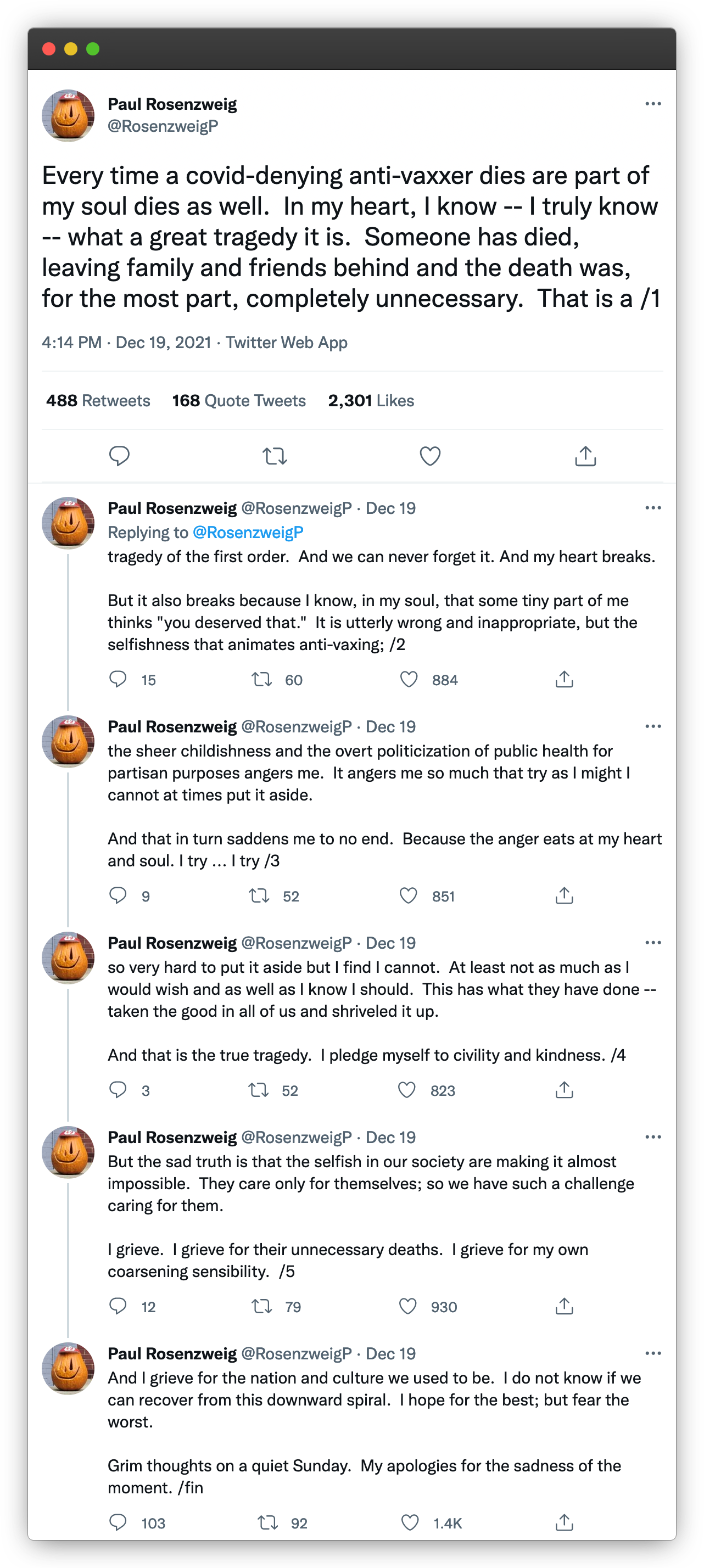
I’m sure I’m not the only one who thinks this. Just the other day, I just saw this other tweet about it too.
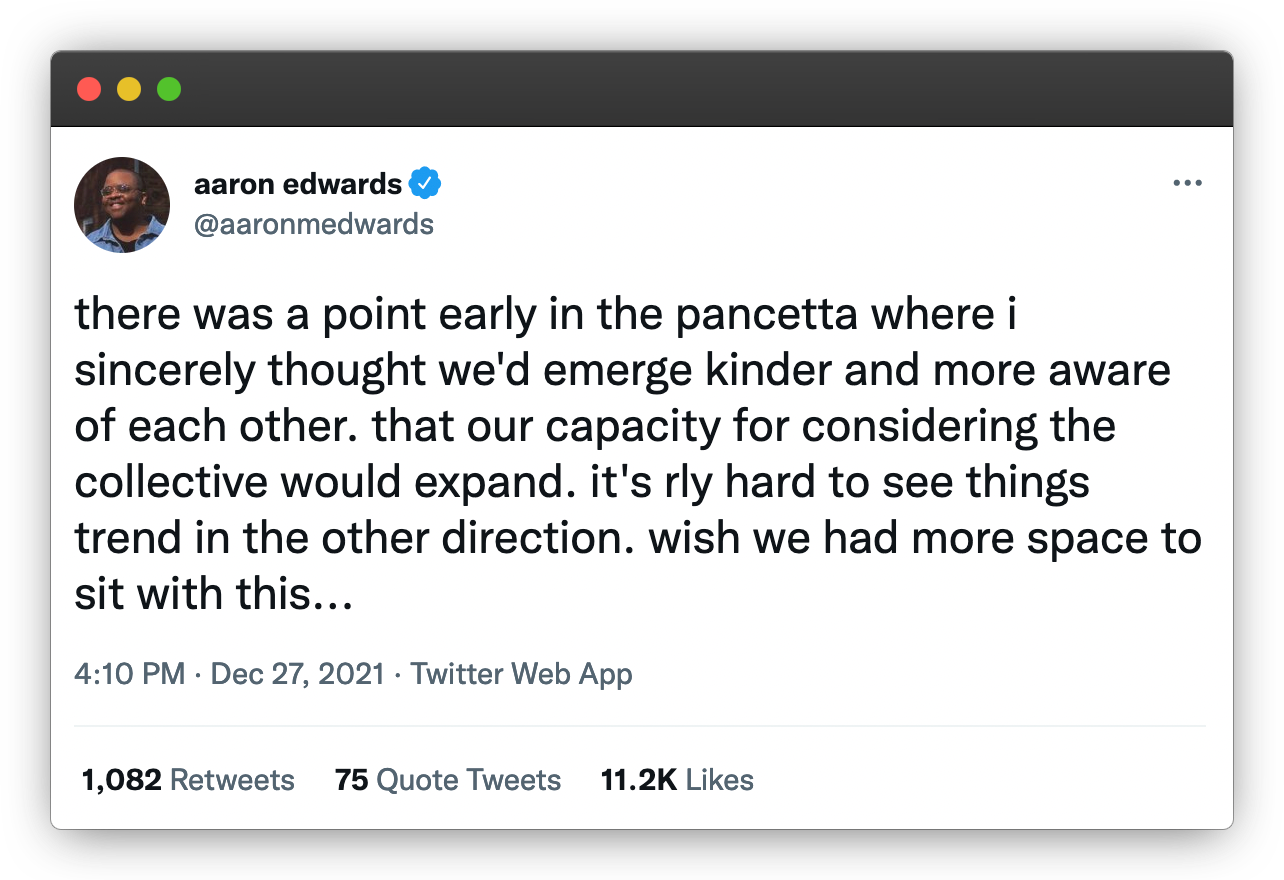
Anyway, this is too much to unpack for just a year in review like this. A lot of it is just my subjective experience. It’s also part of feeling isolated as an extrovert.
But the point is that there’s grief because of COVID. And I’m still processing it because COVID isn’t over for everyone yet. And, as I sit in another lockdown right now, it doesn’t feel over to me.
That said, I hope I can look back and see this was just a passing thing much like Samwise told Frodo in the second half of that quote:
But in the end, it’s only a passing thing, this shadow. Even darkness must pass. A new day will come. And when the sun shines it will shine out the clearer. Those were the stories that stayed with you. That meant something, even if you were too small to understand why. But I think, Mr. Frodo, I do understand. I know now. Folk in those stories had lots of chances of turning back, only they didn’t. They kept going, because they were holding on to something. That there is some good in this world, and it’s worth fighting for.
End of the lockdown and vaccination
As I mentioned earlier, our major lockdown ended Friday May 28th. I went out on a patio that night. Cars were honking, and the mood was festive.
It definitely felt like a weight had been lifted after being in lockdown for so long. That said, the reality was still that I’d only gotten my first vaccine dose. Things were better, but we still had to be safe.
It’s only after my second vaccine dose and the vaccine passport that things felt closer to normal. I started going to the gym again after a year and a half of doing home workouts with cat litter. (Not even joking lol) I started seeing more friends in Montreal.
I even did a small trip in the fall to see some Canadian friends. That trip ended up really draining me. It’s made me realize that I’ll have to rethink how I structure working when I start travelling a lot again.
Omicron and another lockdown
But travelling and all other plans took a backseat with Omicron. We’re back in lockdown here and we also have a curfew. Contrary to earlier in the pandemic, I know a lot of people catching it now.
It’s definitely been a gut punch. I know some people who are defiant to not let it stop them from living their life again. Some have resigned to the idea they’ll get it.
I waver between being defiant and not. Since the beginning of the pandemic, my main fear has been to end up with long COVID. I’m very risk averse to anything that might affect my long-term health.
Long COVID is still very misunderstood. Vaccines don’t seem to prevent you from ending up with it. It makes it hard to assess the risk I’m willing to take.
So I’m still not sure what I’ll do still. This feeds my sense of grief, which I discussed earlier. For now, I’m in a wait and see camp.
But it’s all so exhausting. COVID will probably end up being an endemic disease. If it’s never going away, when is it time to just move on? That’s why I just don’t see myself avoiding travelling for much longer.
Ymir’s first year
Anyway, that’s enough with COVID! The other big story of this year is Ymir. This is the WordPress DevOps platform I announced last year.
Ymir just had its first year in business. I spent most of the year working on it. And, much like COVID, it’s been a roller coaster lol
Launching out of early access
Ymir launched in early access last year. I discussed it last year, but that early access launch did nothing. No one tried Ymir, so I got no early adopters.
After a rough January, I got my act together and launched Ymir out of early access on February 12th. I got three customers that day. That’s two more customers than I expected since Ymir’s first customer was me lol
Building in public
I always wanted to build Ymir in public. I just like the idea of documenting the journey. Much like I do with these year in reviews.
That said, I didn’t really have a good template to follow. This changed in January. I read Jon’s journey to 10k MRR with Bannerbear.
I really liked the idea of having a two-week cycle with one week for product development and one week for marketing. You then capped it off with a report going over what you did. This format gave me structure, made sure I spent time on marketing, and also kept me accountable with the reports.
So I started doing that right away when I launched out of early access. I sent my first report that week. I’ve been doing it since then.
Note: I’m not going to go over everything I wrote in those reports. But, if you’re curious about what happened with Ymir throughout the year, you can find them here.
I also created a public dashboard where you can see statistics about Ymir’s business. Again, it’s a ripoff of Bannerbear’s public dashboard. But it’s again useful to have an idea how things are going.
Slow growth
And speaking of the public dashboard, if you check it out, you’ll see that Ymir has been growing! At first, I thought I’d reach $1000 MRR this year. But starting in August, I had three months without any revenue growth. (There’s a bug with Chartmogul for August and September, growth was actually flat those two months.)
That period was hard. I was churning a lot of customers. SaaS is a numbers game and I just didn’t have a lot new customers to offset the churn.
During that time, I added a free trial to Ymir after resisting for a while. I can’t say it did much of a difference so far. I don’t think the new customers I’ve had since then cared that I had one or not.
Marketing is still hard
Last year, I wasn’t sure how I’d market Ymir. At the end of 2021, I’m still not sure how to market Ymir. So the situation hasn’t changed much on that front.
Building in public, while something that’s been good for me, hasn’t really moved the needle significantly. I’ve written a lot for the Ymir blog. (More on that in the writing section!) I want it to be the destination for articles about running WordPress/WooCommerce on AWS. Based on well it worked for this site with object-oriented programming, I think it’ll be a good long-term investment.
Outside SEO, I’ve done Q&A videos that I’ve published on the Ymir YouTube channel. I’ve been active on Twitter a lot where I do threads whenever I can. I was also on a Do the Woo podcast.
This actually led to me becoming a podcast host for them next year. A lot of people use podcasting as a marketing channel, but it’s a lot of work. This might let me leverage it as a marketing channel without as much of the work!
Otherwise, I have a few other channels I can try. There are cold emails which I really don’t want to do. There’s also doing a webinar which I want to try out.
Legitimacy needed
But the reality is that until there’s a certain level of interest and buy-in from the larger WordPress community, marketing will be hard. This is new technology. It’s got a name that doesn’t inspire confidence. (Aren’t there servers with serverless?)
I have a few behind-the-scenes cheerleaders that are helping me. Zach Stepek, especially, has been a staunch believer and been so helpful this year. Till Krüss too. (Thank you <3)
I really appreciate the help because networking has been hard for me with COVID. It’s a different skill set to network online. I’m just so much better at it in person.
In the meantime, I will obviously keep writing and sharing things about Ymir. But it’s still just me yelling into the void about my product. Next year, I should start having some good case studies for WooCommerce businesses. That should help.
That said, Ymir is a developer product too. They’re the people I want the most as customers. But so far interest is minimal, which is too bad considering how much Laravel developers love Vapor.
The good news is as Vapor gets more popular. More developers will look into the same thing with WordPress. Someone even wrote about it already.
How I feel about Ymir at the end of 2021
One year later, I still have a lot of mixed feelings about Ymir. I’m still embarrassed about the state of the product sometimes. My roadmap just keeps getting longer.
Technical hurdles
This project is also technically hard. Making WordPress work on AWS Lambda is SO MUCH harder than Laravel. Taylor controls Laravel, I do not control WordPress. Nor do I want to.
But the reality is that there’s an entire WordPress plugin/theme ecosystem out there. It’s hard to support them all. I’ve done a pretty good job so far, though! Almost every plugin and theme works on Ymir.
That said, even if I support most plugins and themes, a lot of them are poorly optimized for serverless. In fact, some WordPress developer best practices don’t scale well with serverless. They assume everything is on the same server.
This realization almost made me just quit at a point this year. Thankfully, Till’s next product, Relay, saved the day. But there are still days where I get overwhelmed by the technical challenges and I want to walk away from it all.
Ymir solves a real valuable problem
In all this technical misery, there’s one shining beacon. There’s no doubt in my mind that Ymir solves a real, expensive technical problem. That’s WooCommerce scaling.
Scaling WooCommerce is hard and almost non-existent at the moment. This means that, if you have a sale and your site goes down, you can end up losing thousands of dollars a minute. This is what me and Julien have been testing this year.
I feel Ymir (and serverless in general) is in the “dilemma zone” (see graph below) as described in the Innovator’s dilemma. It’s clearly a much better product for scaling WooCommerce. But it’s not the best product yet for hosting any WordPress site.
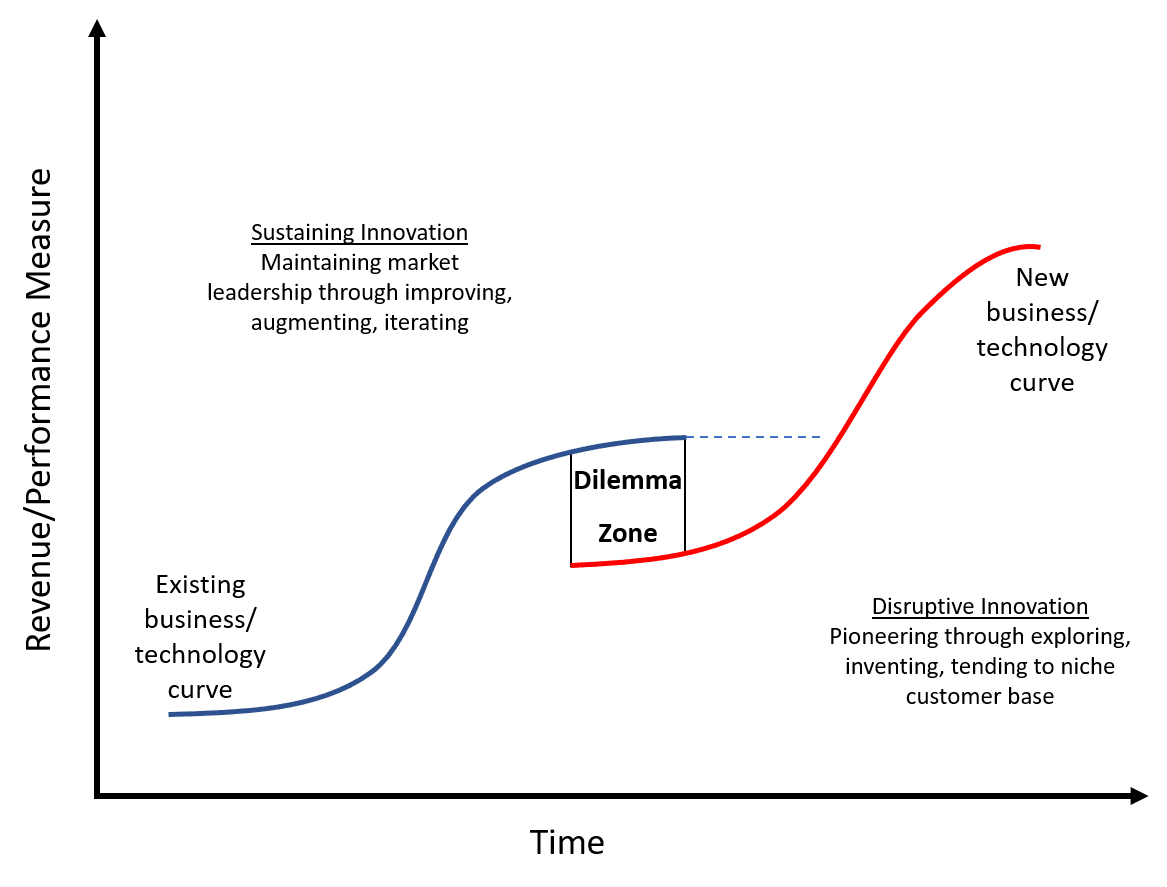
Will it ever get better than hosting a WordPress site on a server? I don’t know. But as processors continue to get faster and computing cheaper, I can see it becoming as good at the very least. At that point, it’s more of a personal preference and maybe the convenience will push it over.
Making Ymir fit my life
The last thing that’s on my mind a lot is how I want Ymir to fit my life. Right now, I work on Ymir pretty much seven days a week in some capacity. And then I also do some consulting to pay the bills since Ymir doesn’t make enough for that yet.
This isn’t sustainable for me. It’s also not what I want.
So what do I want?
Well, I really resonated with this article describing a product as a garden.
That’s what I want from my products. I want to putter about, feel connected to the process, and have fun doing so. I want to make things that don’t scale. To see people tuck into them and enjoy them as people, not as stats.
I’m not looking to build a VC-fueled rocket ship. I have some customers looking to do that using Ymir as their backbone. Good for them! I don’t mind being the Ruby on Rails to their Shopify.
Neither do I necessarily want it to be $XM ARR bootstrapped business. A lot of bootstrapped businesses suffer from the same problem of always looking to grow more. You need more employees, more income, etc. It’s endless.
I want to feel content with Ymir. I want it to be something I enjoy working on and that brings joy to other WordPress developers. I want it to be my garden.
Obviously, it needs to bring me financial sustainability, which it doesn’t at the moment. I also need it to consume less of my time so that I can do more than just work. (Important when I start travelling again.) Those are the two things I care about at the moment.
On writing
This wasn’t my most prolific year of writing. But I wrote 13 articles (including this one) and I have a 14th I delayed until next year. I consider this to be pretty good, all things considered!
At this point, most of the writing is on the Ymir blog. As I said before, that’s the main marketing effort I did this year. I think it’ll pay off.
I still think these are great articles for this site. So you’ll notice they all show up on the article list on the homepage. I put a little external link icon for them.
Traffic
So normally I do a comparison of the web traffic compared to the other year. But last year I switched to Fathom Analytics (rare referral link because it gives you $10 off) as I tried to improve privacy on my site. So I don’t have accurate numbers to see traffic changes between 2020 and 2021.
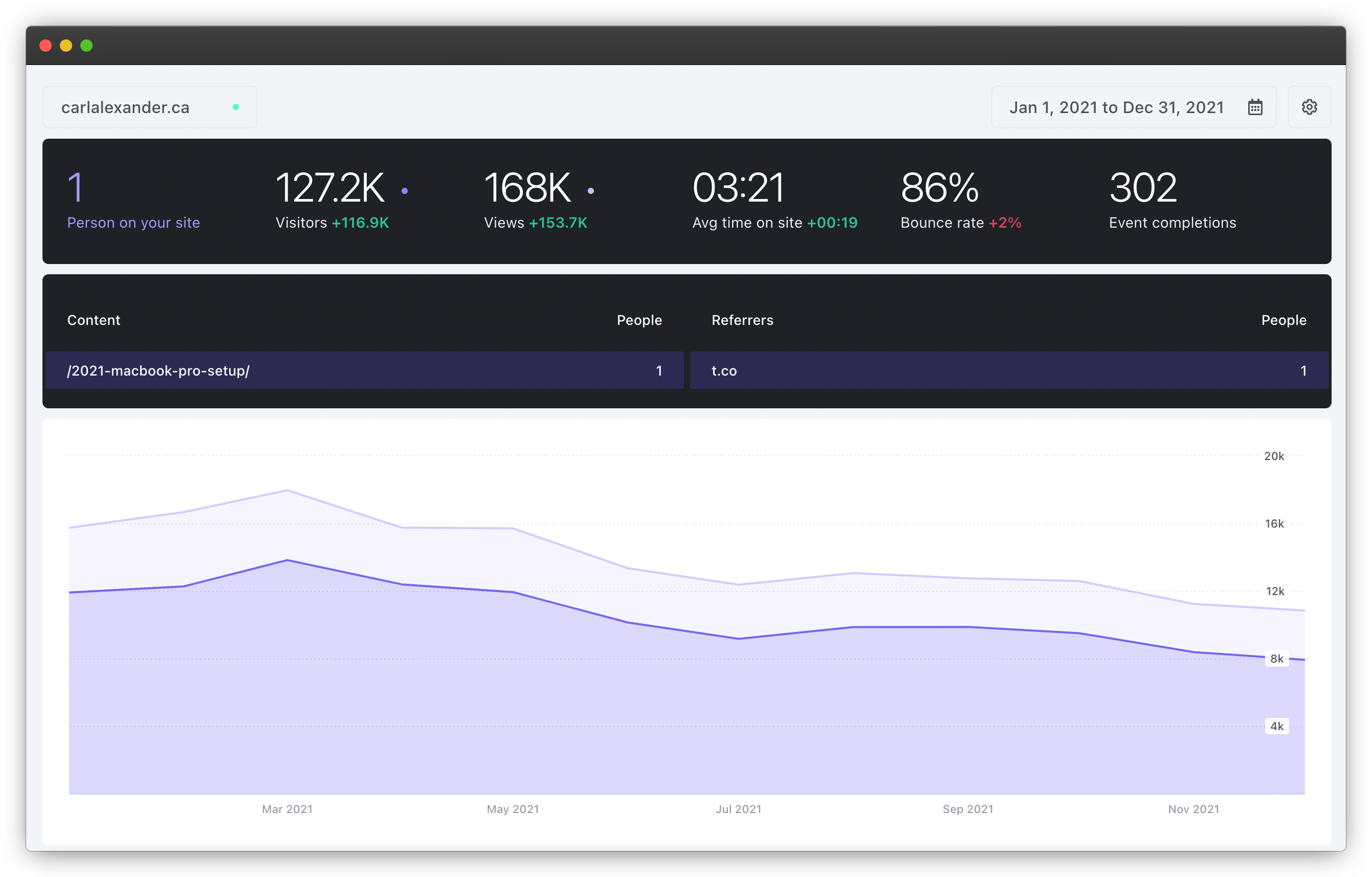
I had roughly 168,000 page views this year. Last year, Google said I got about 140,000. So it seems like traffic has gone up, but we’ll have a better idea next year.
I also don’t have information about traffic sources which, to be honest, is fine. Growing the readership of this site isn’t my main focus anymore. I just want it to be a great resource for WordPress (and eventually Laravel) developers.
And I’m happy it still is!
Top articles of 2021
I enjoy looking at what articles did well each year. To be fair, this list has changed little over the years because that’s the nature of evergreen content. That said, I had a surprise this year!
- What is software complexity and how can you manage it? (14,114 pageviews)
- PHP strings and how to format them (12,667 pageviews)
- Using static factory methods with Laravel models (9,124 pageviews)
- How to use PHP array functions instead of loops (7,169 pageviews)
- Getting started with continuous integration and WordPress (7,053 pageviews)
The surprise is that I have one Laravel article in my top #5! I actually don’t know why it’s so popular. I don’t promote my Laravel articles at all. So this is all SEO or dark social. But it’s still exciting!
Newsletter
My newsletter is pretty much on auto-pilot at this point. I’m really happy I invested time into creating a constant flow of emails before COVID. I just don’t have any time or energy for it now.
I still send emails about Ymir articles to it once in a while. But otherwise, it’s just all automated emails. That said, the newsletter is still growing!
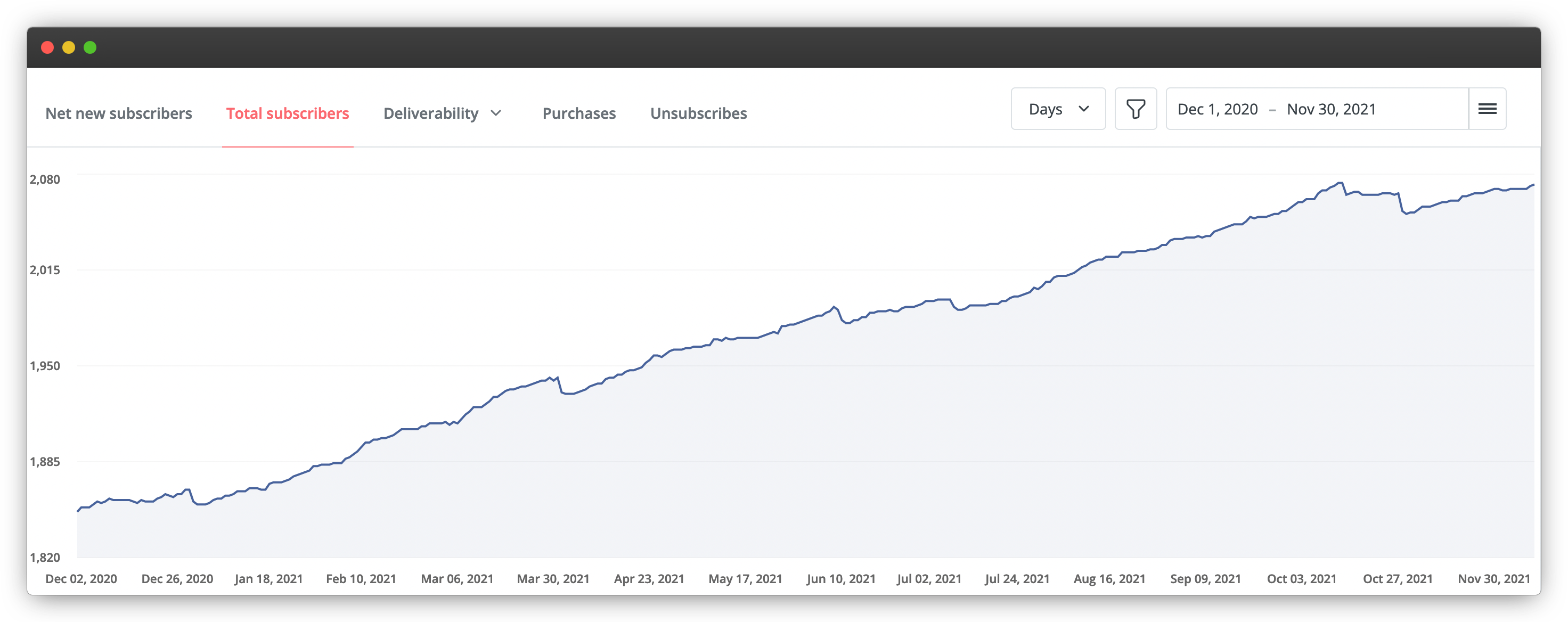
As you can see, I’ve passed the 2,000 subscribers mark. I’m inching close to 2,100. The number of cold subscribers is also down, which is great. I was worried there’d be more of them.
So overall, the newsletter seems pretty healthy.
Money stuff
Last thing to talk about is income. There isn’t much to talk about compared to the other years. I’ve been kind of coasting since my expenses are a lot lower since I’m not travelling.
Income
My main consulting income this year was Global Voices. That was $14,625. I also had some income from the Canadian COVID federal aid.
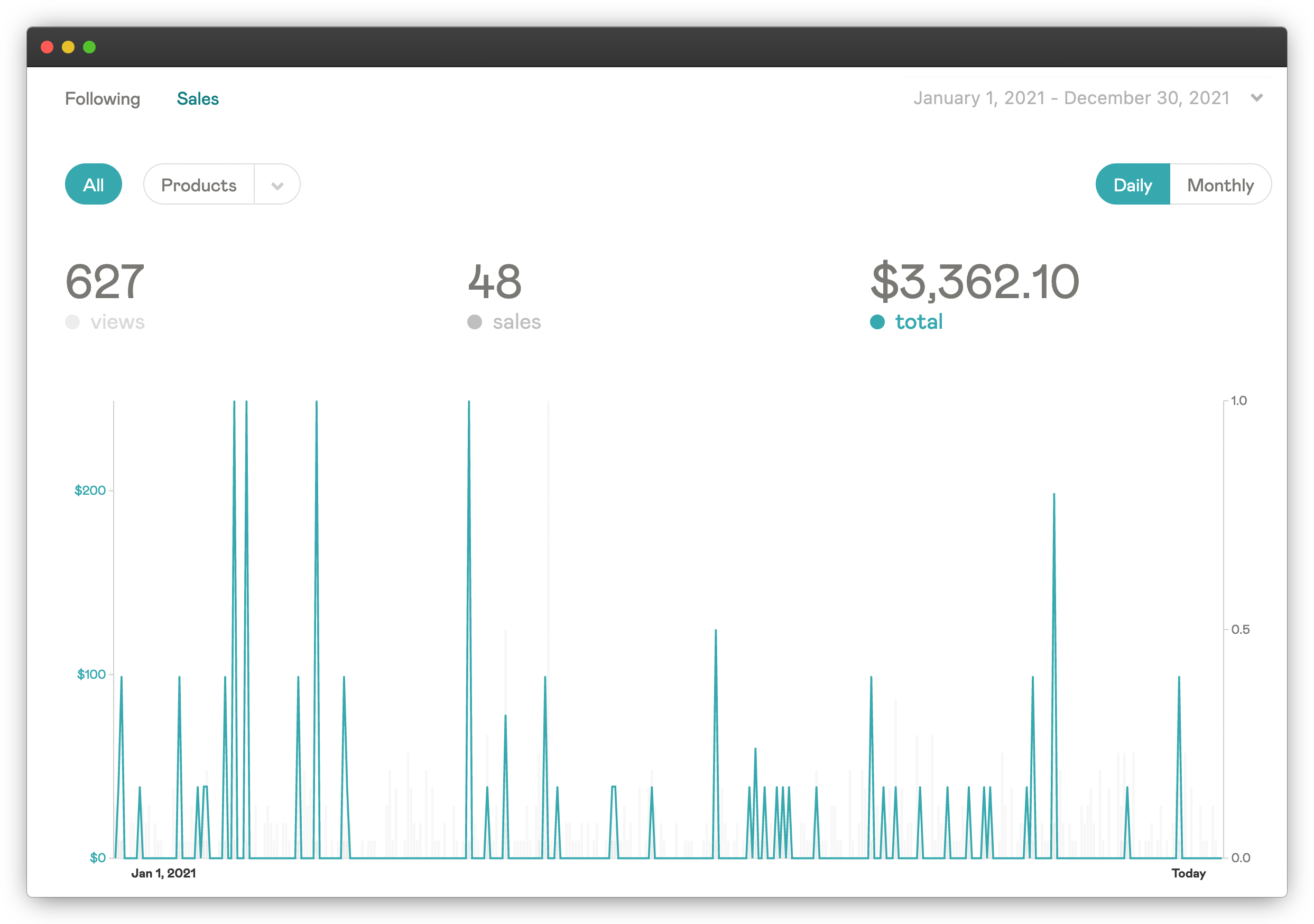
The income from my book came in at $3,362 USD which isn’t bad considering I don’t promote it at all. The lifetime sales for it are at $26,434 USD. It’s way more than I ever expected!
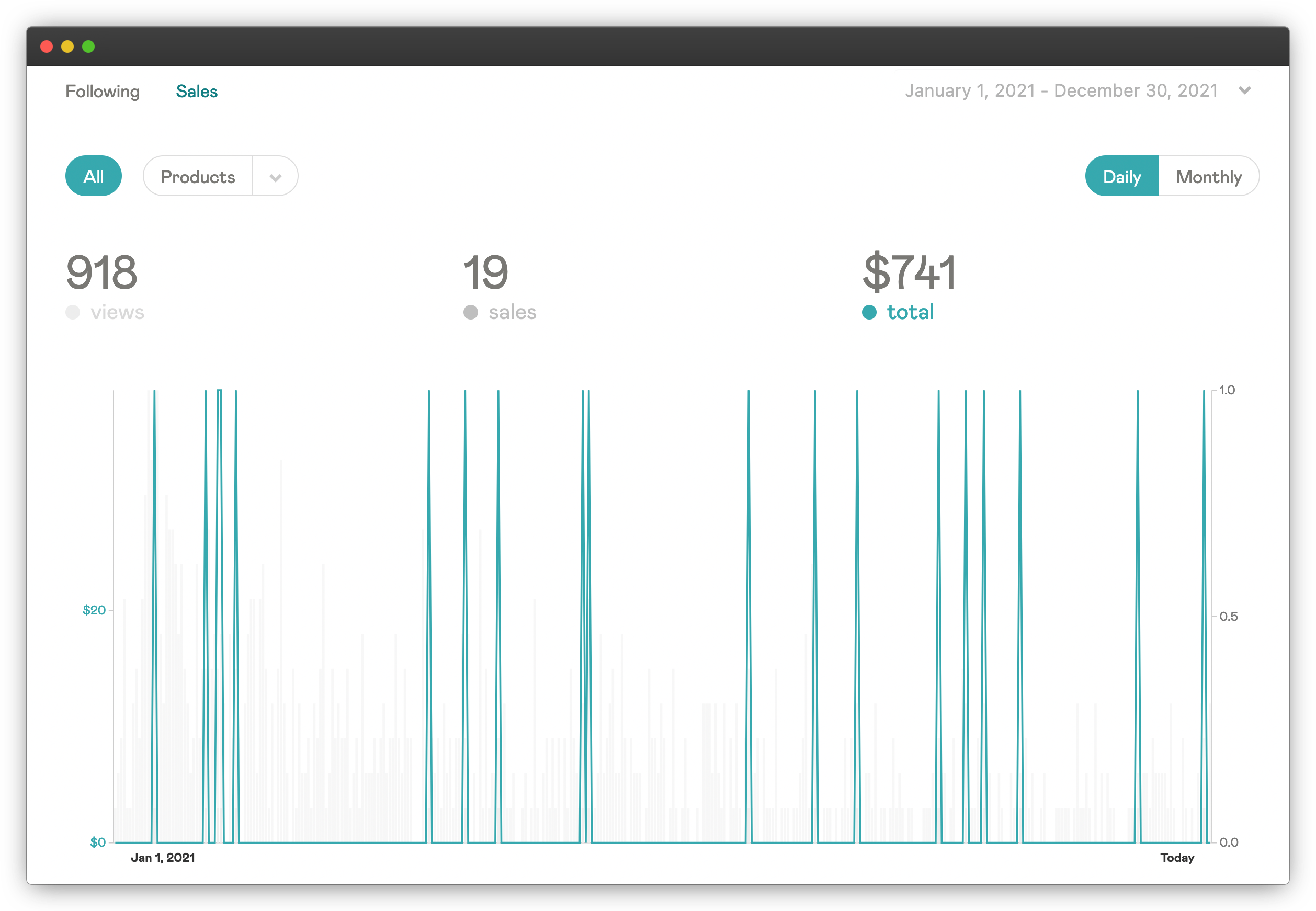
ProductPress continues to make a bit of money each year. (This always surprises me!) It did $741 USD this year.
Adding in some other small consulting gigs. My gross income for the year was around $38,000. Again, it wasn’t a tough year, and I’m thankful to the Canadian government for that.
Expenses
With the lack of travel, expenses weren’t very significant outside buying a new laptop. There were only two major categories:
- Software (with phone): ~$10,000
- Rent: ~$11,000
Both rent and software are up this year. Software more than doubled, but that’s because I’ve invested in more tools this year. I expect it to go down in a year or so.
Beginning of the end?
This was easily the hardest year in review I’ve written. I have trouble remembering how things were before COVID. I’ve been depressed because of it, and it’s hard to feel optimistic about society as a whole.
But I saw a friend not long before the lockdown and discussed how I’d been feeling. She said, “It seems to me, all things considered, you’ve had a pretty successful year.” And she’s right.
If this had been a normal year, I’d be jubilant. Ymir has customers and is growing. It’s not a lot, but it’s also not nothing. (And hopefully not a false-positive.)
I also found a good consulting contract to help support me as a Ymir grows. So, financially, I’m not going broke building Ymir. That said, I’m working a lot more than I’d like right now.
But I’m tired of COVID. (We all are I’m sure.) Half the review was about it because it clouds everything in my life. My only hope for 2022 at this point is that this is the beginning of the end. I just want a small break before we move on to the next challenge of our time.
